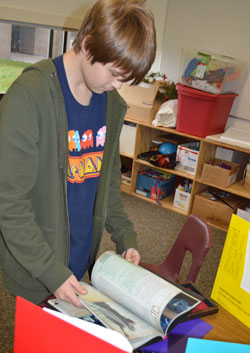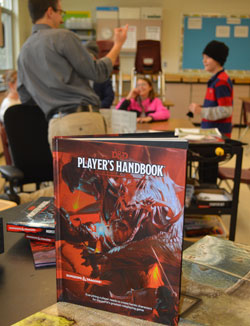For the nearly two dozen Lowell Middle School students in the Dungeons & Dragons club — including a handful of high schoolers — after school is for goblins, dwarves and elves; ice knives, scimitars and war hammers; and mock bludgeoning, blinding and skull crushing.
And lots and lots of laughter, as players of the role-playing game that’s been around since 1972 use probability, strategy and plenty of imagination to imagine themselves in another, action-packed reality.
Eighth grader Elsie Ries started playing last winter, after she got a starter kit for Christmas.
Four random moves heard during a D&D campaign:
• “Feed it the goblin head; then maybe it will leave us alone.”
• “Let’s put the corpses in the tomb; but nudge them first and make sure they’re dead.”
• “They don’t smell very good, but neither does this whole area.”
• “I’m buying armor for my ostrich.”
“I really like to read, and I like how this also lets you put yourself in different places,” Elsie explained.
Added sixth grader Evan Hudson: “You use your brain to make your best decisions.”
Sixth grader Corbyn Kessel is brand new to D&D. “It’s fun and imaginative,” she said, as science teacher by day and after-school Dungeon Master James Grulke sat behind propped-up folders and led that group’s journey — called a campaign.

Growing the Campaign
The school’s Dungeons & Dragons club was started last year with six students. Grulke said a student in one of his classes shared that he played, and, intrigued by memories of his brother playing when they were younger — and by the resurgence of its popularity by those who have seen it on the popular “Stranger Things” Netflix series — Grulke decided to start a club.
By the end of the year there were a dozen, and the once-a-week club this year has 20 regular attendees.
Now more students can join, thanks to a $295 grant from the Lowell Education Foundation that paid for additional books, maps and other supplies.

Not only does the game allow students to work on all eight practices outlined in Next Generation Science Standards adopted by the district; the world-building and fantastical stories hone players’ literacy, math and probability skills, as well as creativity and cooperation.
“This year two students took over as dungeon masters, and we are able to have three groups going at once instead of just one,” Grulke said. “This takes a lot of prior planning and rule knowledge, so it’s fun to see students step up and take this responsibility. It also allows them to go a step forward in playing D&D outside of the club.
“I also love how students are interacting with others they may not have known well before the club. It looks like everyone is having a lot of fun.”
CONNECT
How Dungeons & Dragons primes students for interdisciplinary learning including STEM
How Dungeons & Dragons can help with child development














